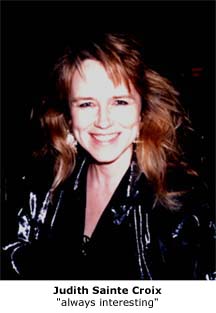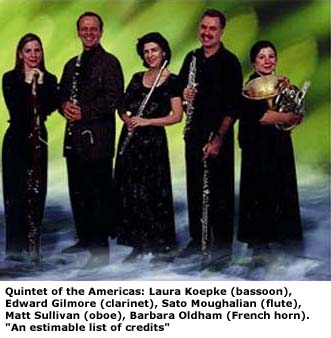

by Barry L. Cohen
'Quintet of the Americas' 25th Anniversary Concert.' Judith Sainte Croix: Vision III* (2002) ~~ Also music by Barros, Villa-Lobos, Crawford-Seeger, Parker, and others. Co-presented by the Americas Society at Salón Simón Bolivar, NY, NY. March 12th. (*world premiere)
At 25 years of age, one would have to consider the Quintet of the Americas a venerable institution, especially in this town where new music groups come and go. It is, in fact, a transplanted organization established in 1976 in Bogotá, Colombia and relocated here three years later. The quintet by now has an estimable list of credits, including residencies, participation in major festivals, concerts in over 300 cities in the Western Hemisphere, and it has awarded more than 30 commissions.
One of these commissions was recently assigned by the quintet to composer Judith Sainte Croix via a National Endowment for the Arts/Chamber Music America Special Commissioning Award. The quintet's collection of indigenous instruments became the basis of a collaboration that was made to order. Ms. Sainte Croix has been engaged in a Vision Series, she says, "to bring Indian and non-Indian people together harmoniously in the concert hall and beyond." (Vision I and II, as well as other similarly inspired works of the composer have been reviewed on these pages in V2#2 and V6#2.) She describes her new work's sonic makeup this way:
Vision III combines indigenous instruments with Western classical instruments of the woodwind quintet. The indigenous instruments played by the quintet include Guatemalan ocarinas, güiros from Mexico and Peru, conch shell, rain sticks, Colombian bamboo finger shakers, zampoľas, Colombian gaitas, pitos, drums and deer hoof rattles.
 The composer has fashioned an ambitious, 30-minute work, which also incorporates a pre-recorded tape and a visual display entitled Festival Images of Central and South America. This display includes masks, mandalas and other objects, which the players took turns holding up during their rests in the score. In its five movements plus prologue, we hear a broad spectrum of exotic ideas that shuffle and tussle but are well balanced and always interesting. Unlike her earlier efforts in this series, which we feel did not gel nor have its forces utilized fully, Vision III brings its limited instrumentation into play early and reaches a sonically full climax in Movement 5, Soaring Above the Festival, built on the timbres of the live instruments and the recorded sounds controlled by the composer and her tape machine.
The composer has fashioned an ambitious, 30-minute work, which also incorporates a pre-recorded tape and a visual display entitled Festival Images of Central and South America. This display includes masks, mandalas and other objects, which the players took turns holding up during their rests in the score. In its five movements plus prologue, we hear a broad spectrum of exotic ideas that shuffle and tussle but are well balanced and always interesting. Unlike her earlier efforts in this series, which we feel did not gel nor have its forces utilized fully, Vision III brings its limited instrumentation into play early and reaches a sonically full climax in Movement 5, Soaring Above the Festival, built on the timbres of the live instruments and the recorded sounds controlled by the composer and her tape machine.
The players were always quite busy both aurally and visually, but they never faltered. We understand they had to learn to play the indigenous instruments from scratch. Especially outstanding was the work of horn player Barbara Oldham, who covered the full register of her instrument often with brazen passages that evoked, among others, Sylvestre Revueltas.
Earlier, the quintet gave a characteristically fine reading of a piece by the Brazilian Heitor Villa-Lobos, Quinteto en forma de chôros (1928, rev. 1953). This composer wrote much music forwind combinations, and this piece is typical of his synthesis of styles, from the rhythmic playfulness of popular music to the nocturnal evocations of the deep forests of Brazil. We consider him a composer unjustly put down by the supposed cognoscenti, but we always enjoy hearing his works, especially the chôros, or "cry," rooted in the life of Rio de Janeiro.
 Somewhat less successful was Ruth Crawford-Seeger's Suite for Woodwind Quintet (1952), a three-movement work that, for all its brevity at under 11 minutes, actually sounded prolix. Without faulting the playing, we simply found the ideas put forth rather unexpressive, though the middle movement, "Lento rubato," seemed to be going somewhere until it suddenly ended. At the other end of the coin, Edmund Cioneks arrangement for woodwind quintet of Charlie Parker Yardbird Suite (1946), has the genuine flavor of progressive jazz - the players sounded like authentic boppers. But the piece took all of two minutes. So why not a really meatier suite of tunes by Parker? Sounds to us like a worthy project, Ed.
Somewhat less successful was Ruth Crawford-Seeger's Suite for Woodwind Quintet (1952), a three-movement work that, for all its brevity at under 11 minutes, actually sounded prolix. Without faulting the playing, we simply found the ideas put forth rather unexpressive, though the middle movement, "Lento rubato," seemed to be going somewhere until it suddenly ended. At the other end of the coin, Edmund Cioneks arrangement for woodwind quintet of Charlie Parker Yardbird Suite (1946), has the genuine flavor of progressive jazz - the players sounded like authentic boppers. But the piece took all of two minutes. So why not a really meatier suite of tunes by Parker? Sounds to us like a worthy project, Ed.
The remainder of the program was given over to popular dance pieces. El Picaflor (The Hummingbird), a charming air by Jose Barros (arr. Francesco Zumaqué) led off the concert. (The composers' national origins were not provided.) At the end of the concert, we heard four Colombian dances by Jorge Olaya Muľoz (1916-1995) and Luis Antonio Calvo (1884-1945). Adding to the festivities was the attendance by some of the composers' surviving kin who were invited to the concert.
The Americas Society's Music director, Maria Elena Tobon, spoke briefly about the society in her introductory remarks. Ms. Oldham was responsible for the program notes.
(Ms. Sainte Croix's CD on her own Sonic Muse label, 'Visions of Light and Mystery,' contains performances of both Vision I and Vision II plus Tukwinong, Dear One and the Bright Leaf Trios.)